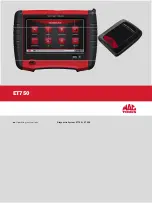
•
Disengage the drive to the cutting unit and shut
off the engine before adjusting the height of
cut (unless you can adjust it from the operating
position).
•
Never run an engine in an area where exhaust
gases are enclosed.
•
Never leave a running machine unattended.
•
Before leaving the operating position (including
to empty the catchers or to unclog the chute), do
the following:
– Park the machine on a level surface.
– Disengage and lower the cutting units and
lower the attachments.
– Engage the parking brake.
– Shut off the engine and remove the key.
– Wait for all moving parts to stop.
•
Do not operate the machine when there is the risk
of lightning.
•
Do not change the governor speed or overspeed
the engine.
•
Do not use the machine as a towing vehicle.
•
Use accessories and attachments approved by
The Toro® Company only.
Rollover Protection System
(ROPS) Safety
•
Do not
remove the ROPS from the machine.
•
Ensure that the seat belt is attached and that you
can release it quickly in an emergency.
•
Check carefully for overhead obstructions and do
not contact them.
•
Keep the ROPS in safe operating condition by
thoroughly inspecting it periodically for damage
and keeping all the mounting fasteners tight.
•
Replace a damaged ROPS. Do not repair or alter
it.
Machines with a Foldable Roll Bar
•
Always use the seat belt with the roll bar in the
raised position.
•
The ROPS is an integral safety device. Keep a
folding roll bar in the raised and locked position,
and use the seat belt when operating the machine
with the roll bar in the raised position.
•
Lower a folding roll bar temporarily only when
necessary. Do not wear the seat belt when the
roll bar is folded down.
•
Be aware that there is no rollover protection when
a folded roll bar is in the down position.
•
Check the area that you will be mowing and never
fold down a folding roll bar in areas where there
are slopes, drop-offs, or water.
Slope Safety
•
Establish your own procedures and rules for
operating on slopes. These procedures must
include surveying the site to determine which
slopes are safe for machine operation. Always
use common sense and good judgment when
performing this survey.
•
Slopes are a major factor related to loss-of-control
and tip-over accidents, which can result in severe
injury or death. Operating the machine on any
slope requires extra caution.
•
Operate the machine at a lower speed when you
are on a slope.
•
If you feel uneasy operating the machine on a
slope, do not do it.
•
Watch for holes, ruts, bumps, rocks, or other
hidden objects. Uneven terrain could overturn the
machine. Tall grass can hide obstacles.
•
Choose a low ground speed so you will not have
to stop or shift while on a slope.
•
A rollover can occur before the tires lose traction.
•
Avoid operating the machine on wet grass. Tires
may lose traction; regardless if the brakes are
available and functioning.
•
Avoid starting, stopping, or turning the machine
on a slope.
•
Keep all movement on slopes slow and gradual.
Do not suddenly change the speed or direction of
the machine.
•
Do not operate the machine near drop-offs,
ditches, embankments, or bodies of water. The
machine could suddenly roll over if a wheel goes
over the edge or the edge caves in. Establish a
safety area between the machine and any hazard
(2 machine widths).
Starting the Engine
Important:
Bleed the fuel system if any of the
following have occurred:
•
The engine has shut off due to lack of fuel.
•
Maintenance has been performed upon the fuel
system components.
1.
Remove your foot from the traction pedal and
ensure that it is in N
EUTRAL
. Ensure that the
parking brake is engaged.
2.
Press down and hold the engine-speed switch
to set the engine to low-idle speed.
3.
Turn the key to the R
UN
position. The glow
indicator should illuminate.
4.
When the glow indicator dims, turn the key to
the S
TART
position.
31
















































